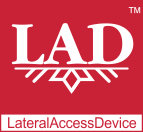
LateralAccessDevice
takes you back to before the Internet
How It Works | Download LAD | Support | LAD Security | Features & Uses | Resources | Members | User Guide
Features & UsesThe LateralAccessDevice (LAD for short) is a purpose-built, multi-dimensional tool for network management and control, now with SIP server and VoIP PBX and Wi-Fi-6E. It is an dedicated operating system (OS) that turns your hardware into a high-performance, multipurpose Internet/network tool that combines multi-dimensional firewalling, monitoring, access control, switching and routing, full packet capture, DNS, NAT and a host of other applications into one easy to use, integrated, high-security package. In simpler terms, it is an all-in-one networking system that you run on your own hardware/computer, converting it into the single piece of equipment that you need for accessing the Internet and running your home or office network securely. It combines the features and functions of a firewall, switch, router, full packet capture appliance and DNS server with network monitoring and visualization. LAD lets you see what is going on throughout your network both at the perimeter and within, between the individual networked devices, down to the level of individual data packets. It lets you monitor, restrict and manage the communications of the computers and other devices on your network both with the Internet and each other, including IoT gadgets, such as IP cameras, that use your network and the Internet as part of their functionality. With LAD you may record all or portions of your network traffic, automatically or on demand, to its encrypted storage. If you see something going on that you don't like, you can block it off and still be able to do the things that you want to do. LAD lets you filter out and disconnect the adware, malware and other unwanted-ware while retaining the connectivity, functions and functionalities that you want with the flexiblity of time of day and day of week scheduling. We are constantly adding to and updating LAD, so the best way to find out what it can do for you is to try it out. Below is a short list of the features LAD offers:
LAD takes you back to before the InternetWhile we say this tongue in cheek, LAD makes it possible to simplify your Internet and network experience by blocking what you don't want and keeping what you do. For example, before the Internet, your security camera couldn't upload its video feed to anywhere without you knowing. Before the Internet, your computer couldn't take part in a DoS (denial of service) campaign to harass and harm others, nor could it secretly keylog (record the key strokes from your keyboard) and send off your banking passwords. LAD lets you reacquire control and visibility into what your computers and other gadgets are doing. In a sense, users' lack of knowledge about what their computers are doing (and inability to do anything about it) are their biggest security threats. Success for the the hacker is directly tied to the user's obliviousness that anything is going on. If you knew that your computer was sending out your secret information, wouldn't you like to know so you could put an end to it? LAD is the tool that lets you do exactly that, without having to give up the Internet that you like. To give an example, some or many users may have run afoul of their ISP's bandwidth rules and had their bandwidth restricted, without knowing the reason why. In some cases, unbeknownst to the user, hackers had set up clandestine content distribution services on the users' computers and run gobs of video, audio, image, SPAM and all other imaginable content through the user's internet connection, triggering the ISP's bandwidth restrictions. With LAD in place, those users would have been able to detect the secret (and possibly illicit) distribution of content and take steps to block it off, before they got blocked. Without a way (such as LAD) to detect these types of secret communications, file transfers and the like, however, there isn't much any user could do. How to get LAD |